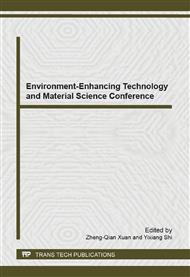p.1
p.7
p.11
p.17
p.23
p.29
p.35
p.39
Poly Acrylic Acid Superabsorbent Hydrogel for Hygiene Materials
Abstract:
Poly acrylic acid (PAA) was synthesized by solution polymerization. We analysed that MBA dosage, acrylic acid percentage, neutralization degree and surface crosslink have affections on PAA, mainly about three properties (including 0.9%NaCl solution's absorptivity, absorptivity under 2068Pa, and holding ability of moisture). The experimental evidence obtained that lower acrylic acid percentage is helpful to these three properties. Indexes increase at first and then decrease with neutralization degree raise. MBA dosage is against to absorptivity and retention capability, but useful to absorptivity under pressure. Scanning electron microscopy (SEM) was used to observe the surface of the PAA powder, and prove that surface crosslink promote form a kind of honeycomb structure. Under the optimum synthetic conditions, the absorptivity of 0.9%NaCl solution is 58.8 times, retention capability is 38.4 times, and absorptivity under 2068Pa is 33.6 times.
Info:
Periodical:
Pages:
7-10
Citation:
Online since:
August 2014
Authors:
Keywords:
Price:
Сopyright:
© 2014 Trans Tech Publications Ltd. All Rights Reserved
Share:
Citation:


